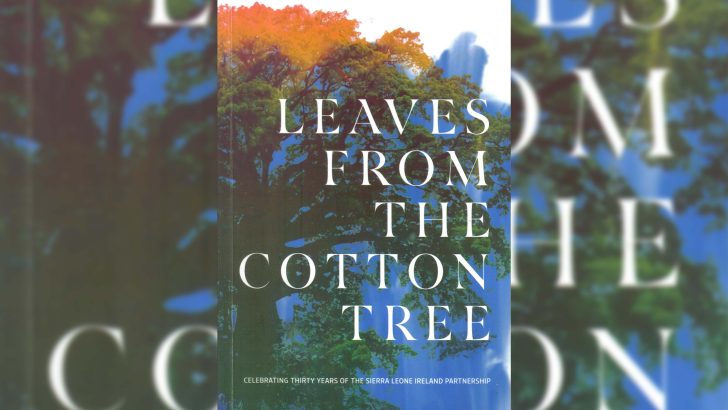Leaves from the Cotton Tree, Celebrating Thirty Years of the Sierra Leone Ireland Partnership, with a foreword by Claire Buckley, Ambassador of Ireland to Sierra Leone, edited by Joseph Bockarie and seven others (SLIP, Kilt ale, Dunsany, Co. Meath, €15.00 + $5.00 p+p; email martindillon@slip.ie for payment details.)
The cotton tree of the title stands in the centre of Freetown, the capital of Sierra Leone, on the coast of West Africa, on what was once called “the Whiteman’s grave” because of the tropical diseases rife there which made off with countless traders.
The tree is said to be hundreds of years old, to have been there even when the British came at the end of the 18th Century. It still flourishes after all those years, and can be seen as a sort of symbol of the history of Sierra Leone itself, a country founded for freed British slaves. Though a great tree grows and changes all the time, it remains the same tree at its core.
Development
This is a book which will interest anyone at all concerned with the development of modern Africa. Sierra Leone was much more important in the last two centuries than it is today, as it was almost the first base the British had on the bight of Africa. But Africa, which might once have seemed unchanging, is now known to be a place of continuing change.
Graham Greene, the novelist, was based there as a British intelligence officer keeping an eye on Vichy controlled French Guinea. That was in 1942 and it later gave rise to his novel The Heart of the Matter (1948).
He came back to Freetown for Christmas 1967 and was astonished at the change. The population had grown. The shabby little house he had once lived in was now brightly painted, and the garden around it, then filled with weeds, was now beautifully laid out with flowers and shrubs. The rickety hotels of the old days had been replaced by shining modern ones. The streets were filled with cars, and crowded with people.
One of the 37 contributors to this book, Frank Roden, who went to Sierra Leone to teach in 1967, went back there in 2016, and like Greene was astounded by the changes, though in between times there had been a civil war and viral epidemic.
As one reads, various aspects of Sierra Leone passing through these great changes come before our eyes. All the contributors wish the country well and want to see it thrive. As it improves the people may look around at their immediate neighbours, such as Guinea or Nigeria, and see that the region as a whole remains deeply troubled.
Overall this book provides a panorama of Irish involvement in various aspects of this ever changing Sierra Leone. But it was a task that had to reconcile both the new ways with the old traditions. Africa today is largely young and urban. Zaire, for instance, now the largest city in Africa and growing fast, was a riverbank muddle of huts in the 1890s. This vitality is the great contrast with the old colonial Africa and with the early years of independence.
Striking
There is something striking, or at least of great interest, in every article. But it is the details that strike one and remain in one’s memory. Sr Hilary Lyons, for instance, recalls an incident from 1997.
Called across to the clinic in Cameroon, where she was then serving, she arrived by the patient’s bedside to find a hen sitting on her head, a traditional healer also by the bedside. Her account of how she saw the rituals of the healer that night as a reconciliation of development and tradition is an insightful one.
Her acceptance of the healer ran counter to what others felt was Church teaching, but she saw it all from a different angle. “All God made is sacred. According to Thomas Berry and other theologians nothing is profane.” The hen was an important symbol.
Helen Fallon, now at the library in Maynooth, notes the tremendous improvement in library access. Back in 1991 it was hard for local graduates to do research and even harder to submit their research papers to journals in Europe and North America. Now thanks to international support that has greatly improved. Africa’s own ancient and medieval heritage is now being investigated, completely altering perspectives on the past.
Witness
This is a book of witness statements to life and experience in Africa which ought to have a wide readership. This is not the Africa so often presented in our news media, nor is it Graham Greene’s “sweetsoup land”, let alone “the Whiteman’s grave”.
In concert they all present a symphony of Africa, of the real Africa they have all come to love and admire.
Graham Greene’s essay on returning to Sierra Leone in 1967 can be found at the end of his Collected Essays (London: The Bodley Head, 1969)


 Peter Costello
Peter Costello
